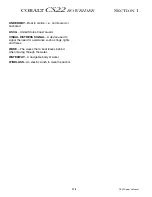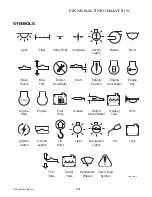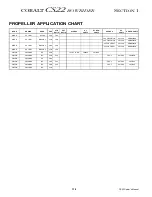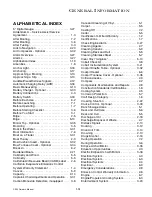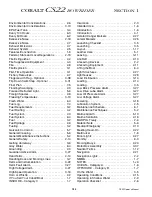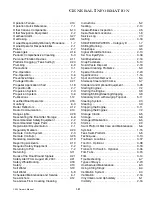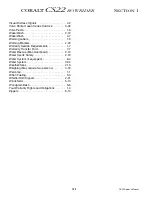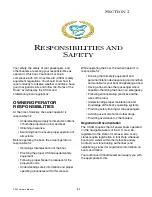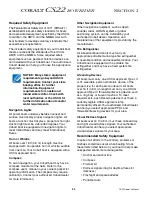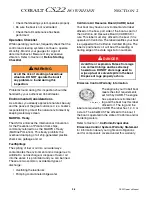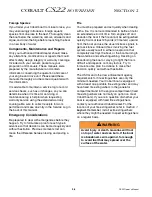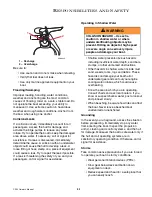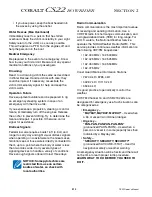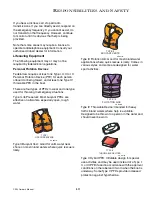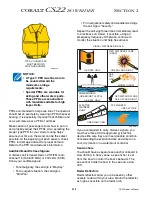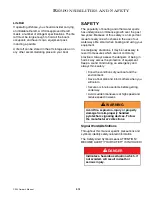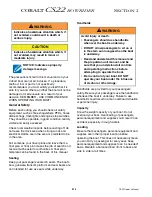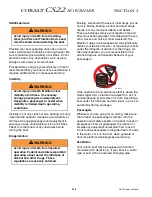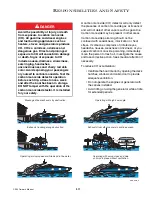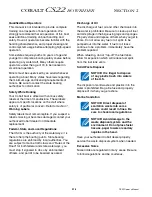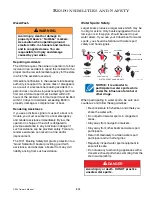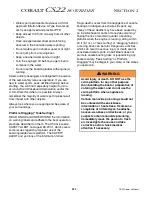
CS22 Owner’s Manual
2
-
5
R
ESPONSIBILITIES
AND
S
AFETY
Make the connection in an open area, free of any
explosive fumes. The connections must be secure
to avoid contact with any water.
Cooling System
The engines and generator, if equipped, are cooled
by the continuous intake of raw water through
independent water intakes. The water flows to
water pumps on the engines and/or generator for
circulation around internal components. The engine
water intakes and outlets are located in the drive
units. A generator water intake is in the bottom of
the hull and the exhaust is usually on the side of the
boat, above the waterline. If your boat is equipped
with an air conditioner, the air conditioner water
intake is in the bottom of the hull and exits from the
side. Your Cobalt boat may be equipped with a
self-contained cooling system that pumps a mixture
of fresh water and antifreeze through a large heat
exchanger to reduce temperatures. Raw water is
circulated through the other side of the heat
exchanger to dissipate heat absorbed by the
coolant mixture.
Exhaust System
The engine and generator exhaust systems, if
equipped, remove the gases produced by the
running engine and vents them away from the boat.
Engine exhaust is usually vented through the drive
unit propeller but may be diverted through the
transom with the optional captain’s call exhaust
system. Engine and generator cooling water are
also removed along with the exhaust gases.
Never change the original exhaust system
configuration. Inspect the entire exhaust system for
tightness before each use. Leaks permit carbon
monoxide exposure. Some boating areas require
the use of a muffler to reduce exhaust sound levels.
Consult your authorized Cobalt dealer for
information.
Lubrication System
The engines and generator, if equipped, use a
pressurized continuous loop lubrication system that
must be periodically serviced in accordance with
the manufacturer’s recommendations. The engines
have electrical transducer units to provide oil
pressure signals to gauges at the helm. Full oil
pressure must be available for proper lubrication,
so monitoring the gauges is important, especially
when operating at cruising speeds and above.
Bilge
A drain plug is located in the transom to allow water
to drain before trailering and storing. Before every
use, inspect the drain plug and bilge pump.
Routinely clean pump strainer, float switch, intake
and area under the pump. It is a violation of federal
law to pump overboard bilge that contains oil or
fuel.
Seaworthiness Inspection
The following checks are essential to safe boating
and must be performed before starting the engines.
Get into the habit of performing these checks in the
same order each time so that it becomes routine.
• Check the weather report, wind and water
conditions.
• Check that required safety equipment is
onboard.
• Check that fire extinguisher(s) is fully charged.
• Check that bilge drain plug is properly installed.
• Check that no fuel, oil or water is leaking or has
leaked into the bilge compartment.
• Check all hoses and connections for leakage
and damage.
• Check that all batteries are fully charged and
have the proper level.
• Check electrical circuits (lights, pumps, horn,
etc.) for proper operation.
A
WARNING
Always install the drain plug before
launching to prevent the boat from
sinking.
Summary of Contents for CS22
Page 2: ...ii CS22 Owner s Manual COBAL T CS22 BOWRIDER ...
Page 8: ...viii CS22 Owner s Manual COBAL T CS22 BOWRIDER NOTES ...
Page 60: ...2 30 CS22 Owner s Manual COBAL T CS22 BOWRIDER SECTION 2 NOTES ...
Page 102: ...4 4 CS22 Owner s Manual COBAL T CS22 BOWRIDER SECTION 4 ...
Page 124: ...6 10 CS22 Owner s Manual COBAL T CS22 BOWRIDER SECTION 6 NOTES ...
Page 132: ...7 8 CS22 Owner s Manual COBAL T CS22 BOWRIDER SECTION 7 NOTES ...


